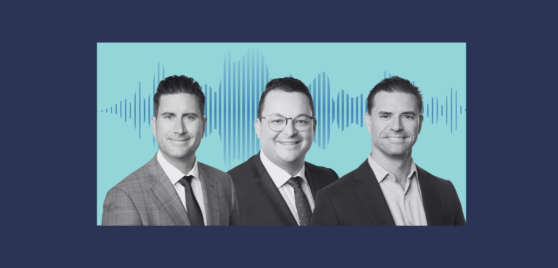Featuring Daniel Moore
LISTEN
READ
In this podcast, IML Portfolio Manager, Daniel Moore, chats to Carl McMinn about a very eventful September quarter. He outlines how the Big 4 Banks and large resources companies drove the ASX 300 over the quarter and affected IML’s large cap performance.
Follow our podcast, ‘Navigating the Noise’ on Spotify, Apple or Amazon to be notified of new episodes.
 |
 |
 |
Lightly edited transcript – recorded on 4 October
Carl McMinn: Hello and welcome to Navigating the Noise, a podcast by Natixis Investment Managers Australia, where we bring you insights from our global collective of experts to help you make better investment decisions. I’m Carl McMinn, distribution director at Natixis. Today I’m joined by Daniel Moore at IML. Dan is Co-PM on the flagship Australian Share Fund and the Industrial Share Fund. Dan is a regular visitor up here to the Sunshine State, where I always enjoy having him visiting with some clients. He’s a student of the market, and I know we’re going to get some great insights today. Dan, welcome to the podcast.
Dan Moore: Hi Carl, great to be here.
Carl McMinn: Good to have you. So Dan, markets, always interesting, following the September quarter. Obviously reporting season, a big part of that, which we covered off in the last episode with you. While markets look strong on the surface, the S&P 500 up 5.9% and the ASX 300 up 7.8% over the quarter, these numbers mask a lot of volatility. Tell us, what drove markets in September.
Dan Moore: Yeah, I think it was certainly a big quarter. A lot happened in that 7.8% return. It really doesn’t summarise what happened. If we go back to August, in that first week of August, markets fell 6% in two days on the back of the Bank of Japan raising rates. I think there was a bit of panic in markets, and at the end of the quarter we ended up 7.8%. So it was a huge turnaround. What drove that turnaround? We saw the Fed cut rates 50 basis points, that helped. But also we saw some China stimulus as well in the last week of September. In the Australian market, the big sectors were banks and resources are up roughly some 10% each. That was a big driver. Obviously we had reporting season as well during the quarter and I would say the results were pretty mixed. Some good results, but also there was definitely pockets of weakness as well. So, a lot going on in the past three months.
Carl McMinn: Tell us more about China. The new stimulus measures have seen a significant rally in the Aussie miners. Can you tell us a bit more about how you see this playing out and the impact on markets going forward?
Dan Moore: Yeah, it certainly had a huge impact on markets. There was a few stimulus measures announced very late September, right in the last week. We saw the Chinese stock market rally over 20%. We saw iron ore commodity prices up 20%. And we saw the iron ore miners up 15 to 40%. So huge moves in a week. When we look the stimulus specifically, interestingly, it’s quite different to what China’s done in the past. There was no real stimulus for construction or fixed asset investment per se. That’s because, if anything, they’ve built too much. There’s an excess of inventory of apartments and fixed asset investment is slowing as well. Because, the country’s pretty urbanised. Really the stimulus was much more focused on the consumer, which is quite weak. So they lowered rates 50 basis points.
The banking sector, they lowered reserve requirements to have a bit more liquidity in the system. They also lowered deposit rates to encourage people to buy property, because there’s a lot of excess inventory on the market right now. But nothing for construction. Which means for us, we sort of understand the movements in the Chinese stock market given that it was extremely weak. But, the moves of commodity prices and the iron ore names is a bit perplexing to us because there’s nothing for construction. The stimulus program is very different to the old days when they used to do stimulus promoting fixed asset investment and shanty town redevelopments.
Carl McMinn: Thanks, Dan. I guess on the other side of the Aussie ASX barbell, what’s the key drivers of the bank returns?
Dan Moore: Yeah, that’s another huge driver of markets. For the year and the quarter, became quite a perplexing one. The Australian banks, as most people know, have had almost no earnings growth for the 12 months. I guess the positive news that’s come out of reporting season is the bad debt outlook continues to be very benign, probably more benign than people realised, including us. That’s just because the LVRs, or the loan to value ratios for mortgages, continues to decline over time as property prices have risen. So, the bank’s loans, particularly for mortgages, are looking in pretty good shape. Even if arrears do tick up, which they are, the losses the banks would face in the event of a foreclosure would be de minimus in most cases. So that outlook’s a bit better. But because bad debts were already so low, you’re still not getting any earnings growth. It is fundamentally difficult to explain a 40-50% move in 12 months. The best explanation we’ve heard or can come up with is the large industry super-funds have been underweight banks, and that’s really hurt their performance. And because of performance tests, they worry about continuing underperformance and they’ve covered some of those underweight positions, causing the banks to rise even further.
Carl McMinn: Classic, crowded trade. These conditions can be pretty challenging for IML’s cautious and defensive investment style. Can you provide a quick overview of how that’s affected IML’s large cap portfolios this quarter?
Dan Moore: The ASX 300 was up 7.8%. We’re well below this, we’re up 4.7% [Australian Share Fund]. In a relative sense, yeah, very disappointing. From an absolute point of view, 4.7’s nothing to be snuffed at. But yes, definitely we are struggling to keep up given the moves in the resource names and the bank names. We always like to look at business performance probably more so than share price performance to make sure we are making the right decisions. It’s really important to remember the share market in the short term is a voting machine, whereas in the long term it’s a weighing machine. Earnings growth of companies over time is the biggest driver of share prices. When we look at the companies we own in the portfolio, they’re performing well. They’ve come out of reporting season, I’d say 90% plus, delivering really good growth in what’s a tricky economic environment. It is not an easy economic environment for companies, and we just know we just got to keep our discipline. IML, we’ve been through multiple cycles over 25 years. We know markets from time to time can get exuberant in pockets and staying true to your process and style wins out overall. We’ve seen that many times in our history.
Carl McMinn: Staying connected to the fundamentals is very important. I agree. Looking at specific holdings within the funds, standout companies over the quarter, who are your best?
Dan Moore: The real highlight was Brambles. Brambles’ the global leader in pallets. Probably you couldn’t get more boring a business than that. They’re up 33% for the quarter. Delivered a fantastic result. Profits were up 17%. But I think people got excited about the future, which we’ve been talking about for a few years now in regards to their investments in digitizing their pallet pool, which is putting GPS trackers within a percentage of them, which helps them track their pallets. Understand where they’re losing pallets and if they can reduce their loss rates, that has a big influence on their cash flow and margins. So, the market’s starting to get a bit more excited about the potential of that, which is nice.
The other one was ResMed. ResMed was up 20%. Another great result in reporting season. But the key I think is the fears around the impact of those weight loss drugs, those GLP-1’s. The evidence is starting to come out now that those drugs actually might increase diagnosis of sleep apnea rather than reduce it. The early data is showing that. We’ve also seen Apple and Samsung with their latest watches have sleep apnea diagnosis as well within those watches, which will help increase diagnosis and provide extra demand for ResMed. ResMed just had an investor day as well, and they were talking about how compliance for their products has improved for patients that are on GLP-1’s as well. Interesting, amazing to think, it wasn’t that long ago you had ResMed’s share prices down 40% on the fear of GLP-1’s, and now it turns out GLP-1’s might be a positive.
Carl McMinn: Everyone wants to get rid of the snorer in their family I’m sure. So still a long way to go for ResMed, but that’s great. But I guess on the other side of the coin, over the quarter, any companies that disappointed, and how did your view change?
Dan Moore: Yeah, unfortunately Light & Wonder, which is a poker machine manufacturer, probably the second largest in the globe behind Aristocrat. They had a bad litigation result go against them and their share price was down 16% in the quarter. It was in regards to one title, title called Dragon Train, which Aristocrat looks to be relatively successful in claiming Light & Wonder stole some IP for that one product. It was a pretty significant reaction just in regards to one title. The company said the earnings impact would be minor and they’ve actually maintained their earnings guidance. We’ve spoken to three or four casino customers in the U.S. and Australia and the feedback is the impact will be very minor. They plan on switching out that game for other games Light & Wonder has, and they’ve got a really strong pipeline of new product coming. Yeah, we actually bought some more on the dip, and in October it’s been bouncing, which is promising.
Carl McMinn: On that note I guess, lots of volatility over the quarter. Pretty sharp drop, early August. Did you get an opportunity to top up any companies or add any new companies to the portfolio?
Dan Moore: We did. We did. The selloff in August was swift, but it only lasted two days. But we were able to do some top-ups there. We bought some more Lottery Corp, which we think is one of the top companies on the ASX. Complete monopoly, multi-decade long licenses. Relatively unregulated pricing. Ability to innovate their games. Good strong digital growth in their online sales with margin expansion. We were able to pick that up when it dipped. Amazingly, its earnings – this is a good example of the market at the moment – their earnings was up over 20% for the year and its share price was only up 2 – 3%. So that’s a company we continue to add to on weakness, a great business trading at a reasonable price. That’s exactly what we’re looking for. We know in the short term, stocks can be forgotten while the market’s chasing other things, but we know longer term that the key is that earnings growth coming through the long run. So we bought some of that.
The other stock we added to was Viva Energy. That’s fallen on weaker short-term refining margins. It’s a relatively small part of the business, refining. The bigger part of their business is their retail business and we see lots of upside there over the next five-seven years. Their retail format currently is very poor. It’s called the Express Retail format. It’s probably one of the worst retail formats in the country, and they’re going to replace that with the OTR format, which is probably the best retail format. That’s an acquisition they made a little while ago and it’s a phenomenal convenience format and very dominant in South Australia. They’re going to roll that format out across their network and we see significant uplift to sales and profits in that retail business as they do that. So good long runway of growth coming, and we’re able to buy that business on a really low multiple, around 11 times earnings.
Carl McMinn: Now to finish up, looking out for the rest of 2024 and to 2025, what’s in store?
Dan Moore: I wish I knew. Look, markets are at very high levels, but there’s a lot going on beneath the surface. I think it’s fair to say the two big sectors, banks look extremely overpriced to us. And on the resource side, they also look really extended given if you look at from an iron ore perspective in particular, which is the big part of the large cap market. But the flip side is in the industrial space there’s some real pockets of opportunity. Some companies that have been left behind in the madness of delivering really good results like Lottery Corp we just talked about or Brambles, that was certainly the case a year or so ago where we see really good opportunities, great valuations for really good businesses. So, there’s opportunities, but at a market index level, there’s some concerns there just given those two big heavyweight sectors look overpriced to us.
Well, thanks for joining me today, Dan. Always appreciate the insights, and thank you, of course, to all our listeners. If you have enjoyed the episode, please click follow on your favorite podcast platform or the bell icon to be notified of future episodes. Tune in again to hear more from our global collective of experts. Thanks very much.
Disclaimer:
This podcast has been prepared and distributed by Natixis Investment Managers Australia Proprietary Limited, ABN 60 088 786 289, AFSL 246830 and includes information provided by third parties, including Investors Mutual Limited (“IML”) AFSL 229988, the responsible entity and investment manager for the IML Funds.
Although Natixis Investment Managers Australia believes that the material in this podcast is correct, no warranty of accuracy, reliability, or completeness is given, including for information provided by third parties except for liability under statute which cannot be excluded. This material is not personal advice. The material is for general information only and does not take into account your personal objectives, financial situation or needs. You should consider and consult with your professional advisor whether the information is suitable for your circumstances. The opinions expressed in the materials are those are the speakers and may not necessarily be those of Natixis Investment Managers Australia or its affiliate investment managers. Before deciding to acquire or continue to hold an investment in a fund, you should consider the information contained in the product disclosure statement in conjunction with the target market determination, TMD, available at www.stg-imlimited-staging.kinsta.cloud.
Past investment performance is not a reliable indicator of future investment performance and no guarantee of performance, return of capital, or a particular rate of return is provided. Any mention of specific company names, securities or asset classes is strictly for informational purposes only and should not be taken as a recommendation to buy, hold, or sell. Any commentary about specific securities is within the context of the investment strategy for the given portfolio. The material may not be reproduced, distributed, or published in whole or in part without the prior written consent of Natixis Investment Managers Australia.
Copyright 2024 Natixis investment Managers Australia. All rights reserved.
INVESTMENT INSIGHTS & PERFORMANCE UPDATES
Subscribe to receive IML’s regular performance updates, invitations to webinars as well as regular insights from IML’s investment team, featured in the Natixis Investment Managers Expert Collective newsletter.
IML marketing in Australia is distributed by Natixis Investment Managers, a related entity. Your subscriber details are being collected by Natixis Investment Managers Australia, on behalf of IML. Please refer to our Privacy Policy. Natixis Investment Managers Australia Pty Limited (ABN 60 088 786 289) (AFSL No. 246830) is authorised to provide financial services to wholesale clients and to provide only general financial product advice to retail clients.







